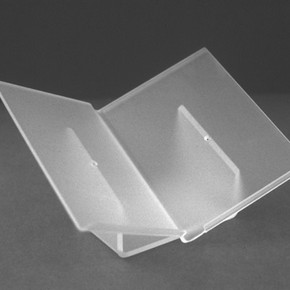Conservation Journal
Autumn 2001 Issue 39
Book display in the British Galleries

Figure 1. Satin finish acrylic book cradle. Photography by Bridget Mitchell (click image for larger version)
In order that the book cradles fulfil the aesthetic criteria of the new galleries, the designer expressed an interest in investigating the use of a more natural looking material than the clear Perspex usually used for book display. Roy Mandeville1 presented the designers with a range of alternative acrylics from which was selected one with a frosted appearance (figure 1). The satin finish of this acrylic overcomes the problem of visual distraction caused by the characteristic highlights (due to the material's ability to channel light) seen at the edges of cradles formed in clear acrylic. Though seemingly opaque, the satin acrylic on contact with objects gives good visibility which allows the binding to be viewed. This acrylic was used almost exclusively for the book supports throughout the new galleries.
The majority of supports were standard in nature: lecterns for closed books; cradles with or without a ledge for books displayed flat or with an angled upstand. The introduction of books displayed within drawers however, required the designing of new supporting structures. Books displayed flat and closed within a drawer had to be supported at head and tail, spine and fore-edge to prevent the book ‘walking’ should the action of the drawer prove more vigorous than promised by manufacturers. A Perspex book tray was designed that was slightly deeper than the volume. The walls of the tray at the head and tail extend and bend around the book to secure the spine and fore-edge. These walls do not run the full length of the volume to allow the book to be placed in the tray with greater ease. All sharp edges on the inside of the tray are sanded away and each volume has text block supports at both head and tail.
Only one volume proved suitable to be displayed open within a drawer. The cradle was designed with a shaped ledge at head and tail, to accommodate the left and right parts of the text block, both parts of which are strapped with polyethylene tape to ensure that no pages slip free. Between the text block and the ledges are precisely fitting text block supports. The left-hand section of the text block is allowed to open with a high arch onto the front board to compensate for the greater angle of opening than would normally be allowed for an open book. It is imperative that all the elements of these supports fit perfectly to prevent the book moving within the support as the drawer is opened and closed.
Acknowledgements
My thanks to Roy Mandeville and my colleagues in Book Conservation for all their help during this project.
References
1. Roy Mandeville, Associate Director Exhibitions at Plowden and Smith.
Autumn 2001 Issue 39
- Editorial
- A concise approach: Managing information for the British Galleries Conservation Programme
- Reverse painting on glass in the British Galleries
- Book display in the British Galleries
- Too big for his boots - Relocation of the Wellington Monument model
- Overview of the gilded objects treated for the British Galleries
- East meets West: The Althorp Triad
- A gun-shield from the armoury of Henry VIII: Decorative oddity or important discovery?
- Conservation or restoration? Treatment of an 18th century clock
- The British Galleries project from a paintings conservation perspective
- Chinese wallpapers in the British Galleries
- Censer: Making Sense of an Object
- Ephemeral or permanent? Illuminating the Bullerswood carpet
- Conservation of a crewelwork bed curtain
- Printer friendly version